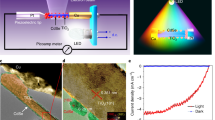Abstract
This paper proposed a new architecture design for nanowire-based quantum-dot-sensitized solar cells to improve the photovoltaic performance. Microstructured rough substrate was used to increase the surface area of the photoanode without influence on charge carrier transport in the system. Compared to conventional devices, the short circuit current density and power conversion efficiency were enhanced by 50%. And the technology can be widely used in the photoelectrochemical (PEC) field, and it can be combined with other hierarchical nanostructures.
Similar content being viewed by others
References
Grätzel M. Dye-sensitized solar cells. Journal of Photochemistry and Photobiology C, Photochemistry Reviews, 2003, 4(2): 145–153
Rühle S, Shalom M, Zaban A. Quantum-dot-sensitized solar cells. ChemPhysChem, 2010, 11(11): 2290–2304
Walter M G, Warren E L, McKone J R, Boettcher S W, Mi Q, Santori E A, Lewis N S. Solar water splitting cells. Chemical Reviews, 2010, 110(11): 6446–6473
Wu J, Chen G, Yang H, Ku C, Lai J. Effects of dye adsorption on the electron transport properties in ZnO nanowire dye-sensitized solar cells. Applied Physics Letters, 2007, 90(21): 213109
Baxter J, Aydil E. Nanowire-based dye-sensitized solar cells. Applied Physics Letters, 2005, 86(5): 053114
Bierman M J, Jin S. Potential applications of hierarchical branching nanowires in solar energy conversion. Energy & Environmental Science, 2009, 2(10): 1050–1059
Xu C, Wu J, Desai U V, Gao D. High-efficiency solid-state dyesensitized solar cells based on TiO2-coated ZnO nanowire arrays. Nano Letters, 2012, 12(5): 2420–2424
Wu X J, Zhu F, Mu C, Liang Y, Xu L, Chen Q, Chen R, Xu D. Electrochemical synthesis and applications of oriented and hierarchically quansi-1D semiconducting nanostructures. Coordination Chemistry Reviews, 2010, 254(9-10): 1135–1150
Ko S H, Lee D, Kang H W, Nam K H, Yeo J Y, Hong S J, Grigoropoulos C P, Sung H J. Nanoforest of hydrothermally grown hierarchical ZnO nanowires for a high efficiency dye-sensitized solar cell. Nano Letters, 2011, 11(2): 666–671
Sauvage F, Di Fonzo F, Li Bassi A, Casari C S, Russo V, Divitini G, Ducati C, Bottani C E, Comte P, Grätzel M. Hierarchical TiO2 photoanode for dye-sensitized solar cells. Nano Letters, 2010, 10(7): 2562–2567
Law M, Greene L E, Radenovic A, Kuykendall T, Liphardt J, Yang P. ZnO-Al2O3 and ZnO-TiO2 core-shell nanowire dye-sensitized solar cells. Journal of Physical Chemistry B, 2006, 110(45): 22652–22663
Lee Y, Chang C. Efficient polysulfide electrolyte for CdS quantum dot-sensitized solar cells. Journal of Power Sources, 2008, 185(1): 584–588
Yu X Y, Liao J Y, Qiu K Q, Kuang D B, Su C Y. Dynamic study of highly efficient CdS/CdSe quantum dot-sensitized solar cells fabricated by electrodeposition. ACS Nano, 2011, 5(12): 9494–9500
Zhao N, Osedach T P, Chang L Y, Geyer S M, Wanger D, Binda M T, Arango A C, Bawendi M G, Bulovic V. Colloidal PbS quantum dot solar cells with high fill factor. ACS Nano, 2010, 4(7): 3743–3752
Zhang J, Gao J, Church C P, Miller E M, Luther J M, Klimov V I, Beard M C. PbSe quantum dot solar cells with more than 6% efficiency fabricated in ambient atmosphere. Nano Letters, 2014, 14(10): 6010–6015
Zaban A, Micic O I, Gregg B A, Nozik A J. Photosensitization of nanoporous TiO2 electrodes with InP quantum dots. Langmuir, 1998, 14(12): 3153–3156
Law M, Greene L E, Johnson J C, Saykally R, Yang P. Nanowire dye-sensitized solar cells. Nature Materials, 2005, 4(6): 455–459
Liu B, Aydil E S. Growth of oriented single-crystalline rutile TiO2 nanorods on transparent conducting substrates for dye-sensitized solar cells. Journal of American Chemical Society, 2009, 131(11): 3985–3990
Author information
Authors and Affiliations
Corresponding authors
Additional information
Heng Li is a Ph.D. candidate of School of Physics at Peking University under the direction of Prof. Dapeng Yu and Prof. Qing Zhao. He received his B.S. degree (2011) in School of Physics from Peking University. He joined Prof. Yu’s group in summer 2011, and he is especially interested in new energy devices such as photovoltaic and energy storage devices.
Jing Wei is a Ph.D. candidate of School of Physics at Peking University under the direction of Prof. Dapeng Yu and Prof. Qing Zhao. She received her B.S. degree (2012) in School of Microelectronics and Solid- State Electronics from University of Electronic Science and Technology of China. She joined Prof. Yu’s group in summer 2012, and she is especially interested in new energy devices such as perovskite solar cells.
Dapeng Yu is a Chang Kung professorship in physics in School of Physics, Peking University. He received his Ph.D. degree (1993) in Laboratoire de Physicque des Solides, Université Paris-sud, Orsay, France, and then joined Department of Physics, Peking University in 1995. His current interests are 1-D semiconductor nanowires, transport in low-D materials, and single DNA detection/sequencing via solid state nanopore microscope.
Qing Zhao got her Ph.D. degree in physics from School of Physics, Peking University. Then she spent three years in University of Washington as a postdoc. She joined School of Physics, Peking University in 2009. Her research area is energy materials and devices in low dimensional, including perovskite solar cells and supercapacitors. The present work proposed a new architecture design for nanowire-based quantum-dot-sensitized solar cells to improve the photovoltaic performance. Microstructured rough substrate was used to increase the surface area of the photoanode without influence on charge carrier transport in the system.
Rights and permissions
About this article
Cite this article
Li, H., Jing, W., Yu, D. et al. Micro-scale hierarchical photoanode for quantum-dot-sensitized solar cells based on TiO2 nanowires. Front. Optoelectron. 9, 53–59 (2016). https://doi.org/10.1007/s12200-016-0565-8
Received:
Accepted:
Published:
Issue Date:
DOI: https://doi.org/10.1007/s12200-016-0565-8




